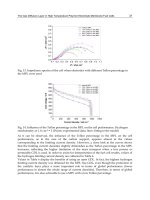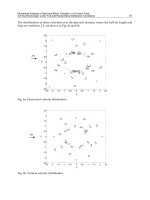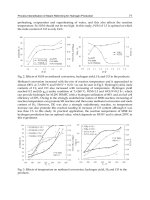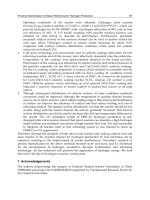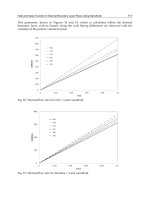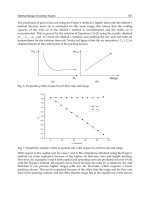CONVECTIVE HEAT AND MASS TRANSFER ppt
Bạn đang xem bản rút gọn của tài liệu. Xem và tải ngay bản đầy đủ của tài liệu tại đây (10.43 MB, 548 trang )
CONVECTIVE HEAT AND MASS TRANSFER
This book was developed by Professor S. Mostafa Ghiaasiaan during
10 years of teaching a graduate-level course on convection heat and
mass transfer. The book is ideal for a graduate course dealing with the-
ory and practice of convection heat and mass transfer. The book treats
well-established theory and practice on the one hand; on the other
hand, it is enriched by modern areas such as flow in microchannels and
computational fluid dynamics–based design and analysis methods. The
book is primarily concerned with convective heat transfer. Essentials
of mass transfer are also covered. The mass transfer material and prob-
lems are presented such that they can be easily skipped, should that be
preferred. The book is richly enhanced by exercises and end-of-chapter
problems. Solutions are available for qualified instructors. The book
includes 17 appendices providing compilations of most essential prop-
erties and mathematical information for analysis of convective heat
and mass transfer processes.
Professor S. Mostafa Ghiaasiaan has been a member of the Woodruff
School of Mechanical Engineering at Georgia Institute of Technology
since 1991 after receiving a Ph.D. in Thermal Science from the Univer-
sity of California, Los Angeles, in 1983 and working in the aerospace
and nuclear power industry for eight years. His industrial research
and development activity was on modeling and simulation of transport
processes, multiphase flow, and nuclear reactor thermal hydraulics
and safety. His current research areas include nuclear reactor thermal
hydraulics, particle transport, cryogenics and cryocoolers, and multi-
phase flow and change-of-phase heat transfer in microchannels. He
has more than 150 academic publications, including 90 journal arti-
cles, on transport phenomena and multiphase flow. Among the hon-
ors he has received for his publications are the Chemical Engineering
Science’s Most Cited Paper for 2003–2006 Award, the National Heat
Transfer Conference Best Paper Award (1999), and the Science Appli-
cations International Corporation Best Paper Award (1990 and 1988).
He has been a member of American Society of Mechanical Engineers
(ASME) and the American Nuclear Society for more than 20 years
and was elected an ASME Fellow in 2004. Currently he is the Exec-
utive Editor of Annals of Nuclear Energy for Asia, Africa, and Aus-
tralia. This is his second book with Cambridge University Press—the
first was Two-Phase Flow, Boiling, and Condensation, In Conventional
and Miniature Systems (2007).
Convective Heat and Mass Transfer
S. Mostafa Ghiaasiaan
Georgia Institute of Technology
cambridge university press
Cambridge, New York, Melbourne, Madrid, Cape Town,
Singapore, S
˜
ao Paulo, Delhi, Tokyo, Mexico City
Cambridge University Press
32 Avenue of the Americas, New York, NY 10013-2473, USA
www.cambridge.org
Information on this title: www.cambridge.org/9781107003507
c
S. Mostafa Ghiaasiaan 2011
This publication is in copyright. Subject to statutory exception
and to the provisions of relevant collective licensing agreements,
no reproduction of any part may take place without the written
permission of Cambridge University Press.
First published 2011
Printed in the United States of America
A catalog record for this publication is available from the British Library.
Library of Congress Cataloging in Publication data
Ghiaasiaan, Seyed Mostafa, 1953–
Convective heat and mass transfer / Mostafa Ghiaasiaan.
p. cm.
Includes bibliographical references and index.
ISBN 978-1-107-00350-7 (hardback)
1. Heat – Convection. I. Title.
QC327.G48 2011
536
.25 – dc22 2011001977
ISBN 978-1-107-00350-7 Hardback
Cambridge University Press has no responsibility for the persistence or accuracy of
URLs for external or third-party Internet Web sites referred to in this publication
and does not guarantee that any content on such Web sites is, or will remain,
accurate or appropriate.
To my wife Pari Fatemeh Shafiei, and my son Saam
CONTENTS
Preface page xv
Frequently Used Notation xvii
1 Thermophysical and Transport Fundamentals 1
1.1 Conservation Principles 1
1.1.1 Lagrangian and Eulerian Frames 1
1.1.2 Mass Conservation 2
1.1.3 Conservation of Momentum 3
1.1.4 Conservation of Energy 6
1.2 Multicomponent Mixtures 11
1.2.1 Basic Definitions and Relations 11
1.2.2 Thermodynamic Properties 15
1.3 Fundamentals of Diffusive Mass Transfer 17
1.3.1 Species Mass Conservation 17
1.3.2 Diffusive Mass Flux and Fick’s Law 18
1.3.3 Species Mass Conservation When Fick’s Law Applies 19
1.3.4 Other Types of Diffusion 20
1.3.5 Diffusion in Multicomponent Mixtures 20
1.4 Boundary and Interfacial Conditions 22
1.4.1 General Discussion 22
1.4.2 Gas–Liquid Interphase 24
1.4.3 Interfacial Temperature 24
1.4.4 Sparingly Soluble Gases 27
1.4.5 Convention for Thermal and Mass Transfer Boundary
Conditions 30
1.5 Transport Properties 31
1.5.1 Mixture Rules 31
1.5.2 Transport Properties of Gases and the Gas-Kinetic Theory 32
1.5.3 Diffusion of Mass in Liquids 37
1.6 The Continuum Flow Regime and Size Convention for Flow
Passages 38
Problems 39
vii
viii Contents
2 Boundary Layers 44
2.1 Boundary Layer on a Flat Plate 44
2.2 Laminar Boundary-Layer Conservation Equations 48
2.3 Laminar Boundary-Layer Thicknesses 51
2.4 Boundary-Layer Separation 53
2.5 Nondimensionalization of Conservation Equations and
Similitude 54
Problems 58
3 External Laminar Flow: Similarity Solutions for Forced Laminar
Boundary Layers
61
3.1 Hydrodynamics of Flow Parallel to a Flat Plate 61
3.2 Heat and Mass Transfer During Low-Velocity Laminar Flow
Parallel to a Flat Plate 65
3.3 Heat Transfer During Laminar Parallel Flow Over a Flat Plate
With Viscous Dissipation 71
3.4 Hydrodynamics of Laminar Flow Past a Wedge 73
3.5 Heat Transfer During Laminar Flow Past a Wedge 78
3.6 Effects of Compressibility and Property Variations 80
Problems 85
4 Internal Laminar Flow 90
4.1 Couette and Poiseuille Flows 90
4.2 The Development of Velocity, Temperature, and Concentration
Profiles 94
4.2.1 The Development of Boundary Layers 94
4.2.2 Hydrodynamic Parameters of Developing Flow 97
4.2.3 The Development of Temperature and Concentration
Profiles 100
4.3 Hydrodynamics of Fully Developed Flow 103
4.4 Fully Developed Hydrodynamics and Developed Temperature or
Concentration Distributions 107
4.4.1 Circular Tube 107
4.4.2 Flat Channel 110
4.4.3 Rectangular Channel 113
4.4.4 Triangular Channel 113
4.4.5 Concentric Annular Duct 114
4.5 Fully Developed Hydrodynamics, Thermal or Concentration
Entrance Regions 117
4.5.1 Circular Duct With Uniform Wall Temperature Boundary
Conditions 117
4.5.2 Circular Duct With Arbitrary Wall Temperature
Distribution in the Axial Direction 124
4.5.3 Circular Duct With Uniform Wall Heat Flux 126
4.5.4 Circular Duct With Arbitrary Wall Heat Flux Distribution
in the Axial Coordinate 129
Contents ix
4.5.5 Flat Channel With Uniform Heat Flux Boundary
Conditions 130
4.5.6 Flat Channel With Uniform Wall Temperature Boundary
Conditions 132
4.5.7 Rectangular Channel 135
4.6 Combined Entrance Region 135
4.7 Effect of Fluid Property Variations 137
Appendix 4A: The Sturm–Liouville Boundary-Value Problems 141
Problems 141
5 Integral Methods 151
5.1 Integral Momentum Equations 151
5.2 Solutions to the Integral Momentum Equation 153
5.2.1 Laminar Flow of an Incompressible Fluid Parallel to a Flat
Plate Without Wall Injection 153
5.2.2 Turbulent Flow of an Incompressible Fluid Parallel to a
Flat Plate Without Wall Injection 156
5.2.3 Turbulent Flow of an Incompressible Fluid Over a Body of
Revolution 158
5.3 Energy Integral Equation 159
5.4 Solutions to the Energy Integral Equation 161
5.4.1 Parallel Flow Past a Flat Surface 161
5.4.2 Parallel Flow Past a Flat Surface With an Adiabatic
Segment 163
5.4.3 Parallel Flow Past a Flat Surface With Arbitrary Wall
Surface Temperature or Heat Flux 165
5.5 Approximate Solutions for Flow Over Axisymmetric Bodies 167
Problems 173
6 Fundamentals of Turbulence and External Turbulent Flow 177
6.1 Laminar–Turbulent Transition and the Phenomenology of
Turbulence 177
6.2 Fluctuations and Time (Ensemble) Averaging 180
6.3 Reynolds Averaging of Conservation Equations 181
6.4 Eddy Viscosity and Eddy Diffusivity 183
6.5 Universal Velocity Profiles 185
6.6 The Mixing-Length Hypothesis and Eddy Diffusivity Models 188
6.7 Temperature and Concentration Laws of the Wall 192
6.8 Kolmogorov Theory of the Small Turbulence Scales 196
6.9 Flow Past Blunt Bodies 200
Problems 205
7 Internal Turbulent Flow 208
7.1 General Remarks 208
7.2 Hydrodynamics of Turbulent Duct Flow 211
7.2.1 Circular Duct 211
7.2.2 Noncircular Ducts 217
x Contents
7.3 Heat Transfer: Fully Developed Flow 218
7.3.1 Universal Temperature Profile i n a Circular Duct 218
7.3.2 Application of Eddy Diffusivity Models for Circular Ducts 221
7.3.3 Noncircular Ducts 224
7.4 Heat Transfer: Fully Developed Hydrodynamics, Thermal
Entrance Region 224
7.4.1 Circular Duct With Uniform Wall Temperature or
Concentration 224
7.4.2 Circular Duct With Uniform Wall Heat Flux 226
7.4.3 Some Useful Correlations for Circular Ducts 229
7.4.4 Noncircular Ducts 231
7.5 Combined Entrance Region 231
Problems 238
8 Effect of Transpiration on Friction, Heat, and Mass Transfer 243
8.1 Couette Flow Film Model 243
8.2 Gas–Liquid Interphase 248
Problems 256
9 Analogy Among Momentum, Heat, and Mass Transfer 258
9.1 General Remarks 258
9.2 Reynolds Analogy 259
9.3 Prandtl–Taylor Analogy 261
9.4 Von Karman Analogy 263
9.5 The Martinelli Analogy 265
9.6 The Analogy of Yu et al. 265
9.7 Chilton–Colburn Analogy 267
Problems 272
10 Natural Convection 275
10.1 Natural-Convection Boundary Layers on Flat Surfaces 275
10.2 Phenomenology 278
10.3 Scaling Analysis of Laminar Boundary Layers 280
10.4 Similarity Solutions for a Semi-Infinite Vertical Surface 285
10.5 Integral Analysis 289
10.6 Some Widely Used Empirical Correlations for Flat Vertical
Surfaces 294
10.7 Natural Convection on Horizontal Flat Surfaces 295
10.8 Natural Convection on Inclined Surfaces 297
10.9 Natural Convection on Submerged Bodies 298
10.10 Natural Convection in Vertical Flow Passages 300
10.11 Natural Convection in Enclosures 304
10.12 Natural Convection in a Two-Dimensional Rectangle With
Heated Vertical Sides 305
10.13 Natural Convection in Horizontal Rectangles 307
10.14 Natural Convection in Inclined Rectangular Enclosures 309
Contents xi
10.15 Natural Convection Caused by the Combined Thermal and
Mass Diffusion Effects 311
10.15.1 Conservation Equations and Scaling Analysis 311
10.15.2 Heat and Mass Transfer Analogy 316
10.16 Solutions for Natural Convection Caused by Combined
Thermal and Mass Diffusion Effects 317
Problems 327
11 Mixed Convection 332
11.1 Laminar Boundary-Layer Equations and Scaling Analysis 332
11.2 Solutions for Laminar Flow 337
11.3 Stability of Laminar Flow and Laminar–Turbulent Transition 341
11.4 Correlations for Laminar External Flow 343
11.5 Correlations for Turbulent External Flow 348
11.6 Internal Flow 349
11.6.1 General Remarks 349
11.6.2 Flow Regime Maps 351
11.7 Some Empirical Correlations for Internal Flow 351
Problems 358
12 Turbulence Models 362
12.1 Reynolds-Averaged Conservation Equations and the Eddy
Diffusivity Concept 362
12.2 One-Equation Turbulence Models 364
12.3 Near-Wall Turbulence Modeling and Wall Functions 367
12.4 The K–ε Model 371
12.4.1 General Formulation 371
12.4.2 Near-Wall Treatment 374
12.4.3 Turbulent Heat and Mass Fluxes 376
12.5 Other Two-Equation Turbulence Models 376
12.6 The Reynolds Stress Transport Models 377
12.6.1 General Formulation 377
12.6.2 Simplification for Heat and Mass Transfer 380
12.6.3 Near-Wall Treatment of Turbulence 380
12.6.4 Summary of Equations and Unknowns 381
12.7 Algebraic Stress Models 381
12.8 Turbulent Models for Buoyant Flows 382
12.9 Direct Numerical Simulation 385
12.10 Large Eddy Simulation 390
12.11 Computational Fluid Dynamics 394
Problems 395
13 Flow and Heat Transfer in Miniature Flow Passages 397
13.1 Size Classification of Miniature Flow Passages 397
13.2 Regimes in Gas-Carrying Vessels 399
13.3 The Slip Flow and Temperature-Jump Regime 402
13.4 Slip Couette Flow 406
xii Contents
13.5 Slip Flow in a Flat Channel 408
13.5.1 Hydrodynamics of Fully Developed Flow 408
13.5.2 Thermally Developed Heat Transfer, UHF 410
13.5.3 Thermally Developed Heat Transfer, UWT 413
13.6 Slip Flow in Circular Microtubes 415
13.6.1 Hydrodynamics of Fully Developed Flow 415
13.6.2 Thermally Developed Flow Heat Transfer, UHF 416
13.6.3 Thermally Developed Flow Heat Transfer, UWT 418
13.6.4 Thermally Developing Flow 420
13.7 Slip Flow in Rectangular Channels 422
13.7.1 Hydrodynamics of Fully Developed Flow 422
13.7.2 Heat Transfer 424
13.8 Slip Flow in Other Noncircular Channels 426
13.9 Compressible Flow in Microchannels with Negligible
Rarefaction 427
13.9.1 General Remarks 427
13.9.2 One-Dimensional Compressible Flow of an Ideal Gas
in a Constant-Cross-Section Channel 428
13.10 Continuum Flow in Miniature Flow Passages 431
Problems 441
APPENDIX A: Constitutive Relations in Polar Cylindrical and Spherical
Coordinates 449
APPENDIX B: Mass Continuity and Newtonian Incompressible Fluid
Equations of Motion in Polar Cylindrical and Spherical Coordinates . . 451
APPENDIX C: Energy Conservation Equations in Polar Cylindrical and
Spherical Coordinates for Incompressible Fluids With Constant Thermal
Conductivity . . 453
APPENDIX D: Mass-Species Conservation Equations in Polar
Cylindrical and Spherical Coordinates for Incompressible Fluids . 454
APPENDIX E: Thermodynamic Properties of Saturated Water and Steam . . . 456
APPENDIX F: Transport Properties of Saturated Water and Steam 458
APPENDIX G: Properties of Selected Ideal Gases at 1 Atmosphere . . . 459
APPENDIX H: Binary Diffusion Coefficients of Selected Gases in Air at
1 Atmosphere 465
APPENDIX I: Henry’s Constant, in bars, of Dilute Aqueous Solutions of
Selected Substances at Moderate Pressures . . . 466
APPENDIX J: Diffusion Coefficients of Selected Substances in Water at
Infinite Dilution at 25
◦
C 467
Contents xiii
APPENDIX K: Lennard–Jones Potential Model Constants for Selected
Molecules 468
APPENDIX L: Collision Integrals for the Lennard–Jones Potential Model . . 469
APPENDIX M : Some RANS-Type Turbulence Models . . . 470
M.1 The Spalart–Allmaras Model 470
M.2 The K–ω Model 472
M.3 The K–ε Nonlinear Reynolds Stress Model 475
M.4 The RNG K–ε Model 477
M.5 The Low-Re RSM of Launder and Shima 478
APPENDIX N: PhysicalConstants 480
APPENDIX O: Unit Conversions . . 482
APPENDIX P: SummaryofImportantDimensionlessNumbers 485
APPENDIX Q: Summary of Some Useful Heat Transfer and
Friction-FactorCorrelations 487
References 501
Index 517
Preface
We live in an era of unprecedented transition in science and technology education
caused by the proliferation of computing power and information. Like most other
science and technology fields, convective heat and mass transfer is already too vast
to be covered in a semester-level course even at an outline level and is yet under-
going exponential expansion. The expansion is both quantitative and qualitative.
On the quantitative side, novel and hitherto unexplored areas are now subject to
investigation, not just by virtue of their intellectual challenge and our curiosity,
but because of their current and potential technological applications. And on the
qualitative side, massive sources of Internet-based information, powerful personal
computers, and robust and flexible software and other computational tools are now
easily accessible to even novice engineers and engineering students. This makes
the designing of a syllabus for courses such as convection heat and mass transfer
all the more challenging. Perhaps the two biggest challenges for an instructor of a
graduate-level course in convection are defining a scope for the course and striking
a reasonable balance between the now-classical analytic methods and the recently
developing modern areas. Although the importance of modern topics and methods
is evident, the coverage of these topics should not be at the expense of basics and
classical methods.
This book is the outcome of more than 10 years of teaching a graduate-level
course on convective heat and mass transfer. It also benefits from my more than
20 years of experience of teaching undergraduate heat transfer and other thermal
fluid science courses to mechanical and nuclear engineering students. The book is
designed to serve as the basis for a semester-level graduate course dealing with
theory and practice of convection heat and mass transfer. My incentive in writing
the book is to strike a balance between well-established theory and practice on the
one hand, and modern areas such as flow in microchannels and computational fluid
dynamics (CFD)–based design and analysis methods on the other. I have had much
difficulty finding such a balance in the existing textbooks while teaching convection
to graduate students and had to rely on my own class notes and recent issues of
journals for much of the syllabi of my classes.
The book is primarily concerned with convective heat transfer. Essentials of
mass transfer are also covered, although only briefly. The mass transfer material
xv
xvi Preface
and problems are presented such that they can be easily skipped, should that be
preferred.
The book consists of 13 chapters. Chapter 1 reviews general and introductory
material that is meant to refresh the student’s memory about the material that he or
she will need to understand the remainder of the book. Chapters 2 and 3 deal with
boundary layers and the transport processes that they control. Chapter 4 discusses
laminar internal flow, in considerably more detail than most similar textbooks, in
recognition of the importance of laminar flow in the now-ubiquitous miniature flow
passages. Chapter 5 discusses the integral method, a classical technique for the
approximate solution of boundary-layer transport equations. The fundamentals of
turbulence and classical models for equilibrium turbulence are discussed in Chap-
ter 6, followed by the discussion of internal turbulent flow in Chapter 7. Chapter 8
is a short discussion of the effect of transpiration on convective transport processes,
and Chapter 9 deals with analogy among heat, momentum, and mass transfer pro-
cesses. Buoyancy-dominated flows are discussed in Chapters 10 and 11.
Chapter 12 is on turbulence models. These models are the bases of the now-
ubiquitous CFD tools. The chapter is primarily focused on the most widely used
Reynolds-averaged Navier-Stokes (RANS)–type turbulent transport models in cur-
rent convective heat transfer research and analysis. The discussions are meant to
show the students where these models have come from, with an emphasis on how
they treat not just the fluid mechanics aspects of turbulent flow but also the trans-
port of heat and mass. Although access to and practice with CFD tools are help-
ful for understanding these turbulence models, the chapter is written in a way that
access to and application of CFD tools are not necessary. Only some of the problems
at the end of this chapter are meant to be solved with a CFD tool. These problems,
furthermore, are quite simple and mostly deal with entrance-dominated internal tur-
bulent flows. Finally, Chapter 13 is a rather detailed discussion of flow in microchan-
nels. The importance of flow in microchannels can hardly be overemphasized. This
chapter discusses in some detail the internal gas flow situations for which significant
velocity slip and temperature jump do occur.
The book also includes 17 appendices (Appendices A–Q), which provide brief
compilations of some of the most essential properties and mathematical information
needed for analysis of convective heat and mass transfer processes.
S. Mostafa Ghiaasiaan
Frequently Used Notation
A Flow or surface area (m
2
); atomic number
a Acceleration (m/s
2
)
a Speed of sound (m/s); one-half of the longer cross-sectional
dimension (m)
a
I
Interfacial surface area concentration (surface area per unit)
mixture volume (m
−1
)
B Blowing parameter
B
h
Mass-flux-based heat transfer driving force
˜
B
h
Molar-flux-based heat transfer driving force
B
m
Mass-flux-based mass transfer driving force
˜
B
m
Molar-flux-based mass transfer driving force
Bi Biot number = hl/k
Br Brinkman number =
μU
2
k
|
T
|
Bo Buoyancy number = Gr/Re
m
b One-half of the shorter cross-sectional dimension (m)
C Concentration (kmol/m
3
)
C
f
Fanning friction factor (skin-friction coefficient)
C
D
Drag coefficient
C
He
Henry’s coefficient (Pa; bars)
C
μ
Constant in the k–ε turbulence model
C
P
Constant-pressure specific heat (J/kg K)
˜
C
P
Molar-based constant-pressure specific heat (J/kmol K)
C
v
Constant-volume specific heat (J/kg K)
˜
C
v
Molar-based constant-volume specific heat (J/kmol K)
D Tube or jet diameter (m)
D
H
Hydraulic diameter (m)
D
ij
Multicomponent Maxwell-Stefan diffusivities for species i and j
(m
2
/s)
D
ij
Binary mass diffusivity for species i and j (m
2
/s)
D
ij
Multicomponent Fick’s diffusivity for species i and j (m
2
/s)
d
j
Diffusion driving force for species j (m
−1
)
E Eddy diffusivity (m
2
/s); gas molecule energy flux (W/m
2
)
xvii
xviii Frequently Used Notation
Ec Eckert number =
U
2
C
P
T
E
1
, E 1D and 3D turbulence energy spectrum functions based on wave
number (m
3
/s
2
)
E
∗
1
, E
∗
1D and 3D turbulence energy spectrum functions based on
frequency (m
2
/s)
E
B
Bulk modulus of elasticity (N/m
2
)
E
ma
Eddy diffusivity for mass transfer (m
2
/s)
E
th
Eddy diffusivity for heat transfer (m
2
/s)
e Total specific advected energy (J/kg)
e Unit vector
F Force (N)
F Eigenfunction
F Dependent variable in momentum mixed-convection similarity
solutions
Fo Fourier number = (
k
ρC
P
)
t
l
2
Fo
ma
Mass transfer Fourier number = D
t
l
2
Fr Froude number = U
2
/
(
gD
)
f Dependent variable in momentum similarity solutions
f Darcy friction factor; frequency (Hz); distribution function (m
−1
or m
−3
); specific Helmholtz free energy (J/kg)
G Mass flux (kg/m
2
s); Gibbs free energy (J); production rate of
turbulent kinetic energy (kg/m s
3
); filter kernel in LES method
Ga Galileo number =
ρ
L
ρ gl
3
μ
2
L
Gr
l
Grashof number =
g βl
3
T
ν
2
Gr
∗
l
Modified Grashof number =
g β q
l
4
v
2
k
Gr
ma,l
Concentration-based Grashof number =
g β
ma
l
3
m
1
ν
2
or
g β
∗
ma
l
3
x
1
ν
2
Gz Graetz number =
4Ul
2
x
ρ C
P
k
g Specific Gibbs free energy (J/kg); gravitational constant
(= 9.807 m/s
2
at sea level)
g Gravitational acceleration vector (m/s
2
)
H Boundary-layer shape factor (= δ
1
/δ
2
); channel height (m)
He Henry number
h Specific enthalpy (J/kg)
h Heat transfer coefficient (W/m
2
K); height (m)
h
r
Radiative heat transfer coefficient (W/m
2
K)
h
fg
, h
sf
, h
sg
Latent heats of vaporization, fusion, and sublimation (J/kg)
˜
h
fg
,
˜
h
sf
,
˜
h
sg
Molar-based latent heats of vaporization, fusion, and sublimation
(J/kmol)
I
m
Modified Bessel’s function of the first kind and mth order
J Diffusive molar flux (k mol/m
2
s)
j Diffusive mass flux (kg/m
2
s); molecular flux (m
−2
s
−1
)
K Turbulence kinetic energy (J/kg)
K Loss coefficient; incremental pressure-drop number
K Mass transfer coefficient (kg/m
2
s)
˜
K Molar-based mass transfer coefficient (kmol/m
2
s)
Frequently Used Notation xix
k Thermal conductivity (W/m K); wave number (m
−1
)
L Length (m)
Le Lewis number =
α
D
l Length (m)
l
c
Characteristic length (m)
l
D
Kolmogorov’s microscale (m)
l
ent,hy
Hydrodynamic entrance length (m)
l
ent,ma
Mass transfer entrance length (m)
l
ent,th
Thermal (heat transfer) entrance length (m)
l
M
Turbulence mixing length ( m)
l
M, ma
Turbulence mixing length f or mass transfer (m)
l
heat
Heated length (m)
l
th
Turbulence mixing length f or heat transfer (m)
M Molar mass (kg/kmol)
Ma Mach number
m Mass fraction; dimensionless constant
m Mass (kg); mass of a single molecule (kg)
m
Mass flux (kg/m
2
s)
N Ratio between concentration-based and thermal-based Grashof
numbers = Gr
l, ma
/Gr
l
N Unit normal vector
N
Molar flux (kmol/ m
2
s)
N
Av
Avogadro’s number (= 6.024 × 10
26
molecules/kmol)
NS Navier-Stokes equation
Nu
l
Nusselt number hl/k
n Total mass flux (kg/m
2
s)
n Component of the total mass flux vector (kg/m
2
s); number density
(m
−3
); dimensionless constant; polytropic exponent
P Property
P Pressure (N/m
2
); Legendre polynomial
Pe
l
Peclet number = Ul
(
ρ C
P
/k
)
Pe
l,ma
Mass transfer Peclet number = Ul/D
Po Poiseuille number =
2τ
s
D
H
μ U
Pr Prandtl number = μ C
P
/k
P
r
Reduced pressure = P/P
cr
Pr
tu
Turbulent Prandtl number
p
f
Wetted perimeter (m)
p
heat
Heated perimeter (m)
p Perimeter (m)
Q Volumetric flow rate (m
3
/s); dimensionless wall
heat flux
˙q Volumetric energy generation rate (W/m
3
)
q
Heat flux (W/m
2
)
R Radius (m); gas constant (Nm/kg K)
R Eigenfunction
Ra
l
Rayleigh number =
g β l
3
T
ν α
xx Frequently Used Notation
Ra
∗
l
Modified Rayleigh number =
g β l
4
q
ν α k
R
c
Radius of curvature ( m)
Re Reynolds number = ρUl/μ
Re
F
Liquid film Reynolds number = 4
F
/μ
L
Re
y
Reynolds number in low-Re turbulence models = ρ K
1/2
y/μ
Ri Richardson number = Gr/Re
2
˙
R
l
Volumetric generation of species l (kmol/m
3
s)
R
u
Universal gas constant (= 8314 Nm/kmol K)
r Distance between two molecules (
˚
A) (Chapter 1); radial
coordinate (m)
r Position vector (m)
˙r
l
Volumetric generation rate of species l (kg/m
3
s)
S Entropy (J/K); distance defining intermittency (m)
S Channel width (m)
Sc Schmidt number v/D
Sh
l
Sherwood number =
Kl
ρ D
or
Kl
C D
S
ij
Component of mean strain rate tensor (s
−1
)
St Stanton number =
h
ρ C
P
U
=
h
C
˜
C
P
U
=
Nu
l
Re
l
Pr
St
ma
Mass transfer Stanton number =
K
ρ U
=
K
C U
=
Sh
l
Re
l
Sc
s Specific entropy (J/kg K)
s Coordinate on the surface of a body of revolution (m)
T Temperature (K)
T Turbulence intensity
T Unit tangent vector
t Time (s); thickness (m)
t
c
Characteristic time (s)
t
c,D
Kolmogorov’s time scale (s)
t
res
Residence time (s)
U Internal energy (J)
U Velocity vector (m/s)
U Overall heat transfer coefficient (W/m
2
K); velocity (m/s)
U
τ
Friction velocity (m/s)
u Specific internal energy (J/kg)
u Velocity in axial direction, in x direction in Cartesian coordinates,
or in r direction in spherical coordinates (m/s)
u
D
Kolmogorov’s velocity scale (m/s)
V Volume (m
3
)
V
d
Volume of an average dispersed phase particle (m
3
)
v Velocity in y direction in Cartesian coordinates, r direction in
cylindrical and spherical coordinates, or θ direction in spherical
coordinates (m/s)
v Specific volume (m
3
/kg)
W Work (J); width (m)
˙
W Power (W)
We Weber number =
ρ U
2
l
σ
Frequently Used Notation xxi
w Velocity in z direction in Cartesian coordinates, in θ direction in
cylindrical coordinates, or in ϕ direction in spherical coordinates
(m/s); work per unit mass
(
W/kg
)
X Mole fraction
Y Parameter represents the effect of fluid compressibility in
turbulence models (kg/m s
3
); height of a control volume (m)
y Normal distance from the nearest wall (m)
Greek Characters
α Thermal (energy) accommodation coefficient
α Thermal diffusivity (m
2
/s)
α
∗
Aspect ratio
β Wedge or cone angle (rad); coefficient of volumetric thermal
expansion (1/K)
β
ma
Coefficient of volumetric expansion with respect to mass fraction
β
∗
ma
Coefficient of volumetric expansion with respect to concentration
(kg/m
3
)
−1
˜
β
ma
Coefficient of volumetric expansion with respect to mole fraction
Correction factor for the kinetic model for liquid-vapor interfacial
mass flux; gamma function
F
Film mass flow rate per unit width (kg/m)
γ Specific heat ration
(
C
P
/C
v
)
; shape factor [(Eq. 4.6.5)]
δ Kronecker delta; gap distance (m); boundary-layer thickness (m)
δ
F
Film thickness (m)
δ
1
,δ
2
,δ
3
,δ
h
Boundary-layer displacement, momentum, energy, and enthalpy
thicknesses (m)
ε Porosity; radiative emissivity; turbulent dissipation rate (W/kg)
˜ε Energy representing maximum attraction between two molecules
(J)
ε
Parameter defined in Eq. (12.4.5) (W/kg)
ε
s
Surface roughness (m); a small number
ζ Parameter defined in Eq. (3.1.26); dimensionless coordinate
η Independent variable in similarity solution equations;
dimensionless coordinate
η
c
Convective enhancement factor
θ Nondimensional temperature; azimuthal angle (rad); angular
coordinate (rad); angle of inclination with respect to the
horizontal plane (rad or
◦
)
K Curvature (m
−1
); coefficient of isothermal compressibility (Pa
−1
)
κ von Karman’s constant
κ
B
Boltzmann’s constant ( = 1.38 × 10
−23
J/K molecule)
λ Wavelength (m); second coefficient of viscosity (−
2
3
μ) (kg/m s);
eigenvalue
λ
mol
Molecular mean free path (m)
μ Viscosity (kg /m s)
ν Kinematic viscosity (m
2
/s)
xxii Frequently Used Notation
ξ Parameter defined in Eq. (3.2.41); variable
ρ Density (kg/m
3
)
σ Normal stress (N/m
2
); Prandtl number for various turbulent
properties; tangential momentum accommodation coefficient
˜σ Molecular collision diameter (
˚
A)
σ
A
Molecular-scattering cross section (m
2
)
σ
c
,σ
e
Condensation and evaporation coefficients
˙σ
gen
Entropy generation rate, per unit volume (J/K m
3
)
τ Molecular mean free time (s); viscous stress (N/m
2
)
τ
Stress tensor (N/m
2
)
τ
Viscous stress tensor (N/m
2
)
Dissipation function (s
−2
); pressure strain term (W/kg)
φ Velocity potential (m
2
/s); pair potential energy (J); inclination
angle with respect to vertical direction (rad or
◦
); normalized mass
fraction
φ
Inclination angle with respect to the horizontal plane (rad or
◦
)
ϕ Relative humidity; nondimensional temperature for mixed
convection
ψ Stream function (m
2
/s)
Specific potential energy associated with gravitation (J/kg);
momentum flux of gas molecules (kg/m s)
k
,
D
Collision integrals for thermal conductivity and mass diffusivity
ij
Component of vorticity tensor (s
−1
)
ω Humidity ratio
Complex velocity potential (m
2
/s)
Superscripts
r Relative
+ Dimensionless; in wall units
.Timerate
− Average; in the presence of mass transfer
–t Time averaged
∗ Dimensionless or normalized; modified for velocity slip or
temperature jump
∼ Molar based; dimensionless
Subscripts
ad Adiabatic
avg Average
b Body force
c Center, centerline
cr Critical
d Dispersed phase
df Downflow
ent Entrance region or entrance effect
Frequently Used Notation xxiii
eq Equilibrium
ev Evaporation
ex Exit
F Forced convection
f Saturated liquid
fd Fully developed
film Film
fr Frictional
G Gas phase
g Saturated vapor; gravitational
H Hartree’s (1937) similarity solution
✐
H1 Boundary conditions in which the temperature is circumferentially
constant while the heat flux is axially constant
heat Heated
hy Hydrodynamic
I Irreversible; gas–liquid interphase
in Inlet
L Liquid phase
lam Laminar
m Mean, bulk
ma Mass transfer
max Maximum
mol Molecular
N Natural convection
n Sparingly soluble (noncondensable) inert species
opt Optimized
out Outlet
R Reversible
rad Radiation
ref Reference
refl Reflected
res Associated with residence time
s Wall surface; s surface (gas-side interphase); isentropic
sat Saturation
T
Uniform wall temperature
th Thermal
tu Turbulent
UC Unit cell
UHF Uniform heat flux
UMF Uniform mass flux
UWM Uniform wall mass or mole fraction
UWT Uniform wall temperature
w Wall
x, z Local quantity corresponding to location x or z
∞ Ambient; fully developed
= Tensor
xxiv Frequently Used Notation
Abbreviations
CFD Computational fluid dynamics
DDES Delayed detached eddy simulation
DES Detached eddy simulation
DNS Direct numerical simulation
DSMC Direct simulation Monte Carlo
GKT Gas-kinetic theory
LES Large-eddy simulation
MMFP Molecular mean free path
ODE Ordinary differential equation
RANS Reynolds-averaged Navier-Stokes
RNG Renormalized group
RSM Reynolds stress model
SGS Subgrid scale
UHF Uniform heat flux
UMF Uniform mass flux
UWM Uniform wall mass or mole fraction
UWT Uniform wall temperature
1D, 2D, 3D One-, two-, and three-dimensional
1 Thermophysical and Transport
Fundamentals
1.1 Conservation Principles
In this section t he principles of conservation of mass, momentum, and energy, as
well as the conservation of a mass species in a multicomponent mixture, are briefly
discussed.
1.1.1 Lagrangian and Eulerian Frames
It is important to understand the difference and the relationship between these two
frames of reference. Although the fluid conservation equations are usually solved
in an Eulerian frame for convenience, the conservation principles themselves are
originally Lagrangian.
In the Lagrangian description of motion, the coordinate system moves with the
particle entity of interest, and we describe the flow phenomena for the moving par-
ticle or entity as a function of time. The Lagrangian method is particularly useful for
the analysis of rigid bodies, but is rather inconvenient for fluids because of the rel-
ative motion of fluid particles with respect to one another. In the Eulerian method,
we describe the flow phenomena at a fixed point in space, as a function of time. The
Eulerian field solution for any property P will thus provide the dependence of P on
time as well as on the spatial coordinates; therefore in Cartesian coordinates we will
have
P = P
(
t, r
)
= P (t, x, y, z). (1.1.1)
The relation between the changes in P when presented in Lagrangian and Eule-
rian frames is easy to derive. Suppose, for a particle in motion, P changes to P + dP
over the time period dt. Because in the Eulerian frame we have P = P(t, x, y, z),
then
dP =
∂P
∂t
dt +
∂P
∂x
dx +
∂P
∂y
dy +
∂P
∂z
dz. (1.1.2)
1




